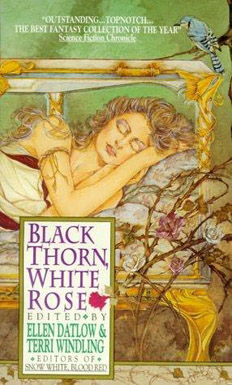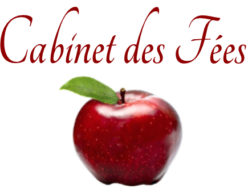Black Thorn, White Rose
Ellen Datlow and Terri Windling (editors)
Reviewed by JoSelle Vanderhooft
 In the 1990s legendary editors Ellen Datlow and Terri Windling assembled a six book anthology series of “fairy tales for adults.” Beginning with 1992’s Snow White, Blood Red and concluding in 2000 with Black Heart, Ivory Bones, these magnificent anthologies not only revolutionized the fantasy genre but laid the groundwork for much of the daring folklore-inspired fantasy (much of it written by young women) being written today. It seems only fitting, then, for Cabinet des Fées to devote a review to a series that is, in part, responsible for the work we do.
In the 1990s legendary editors Ellen Datlow and Terri Windling assembled a six book anthology series of “fairy tales for adults.” Beginning with 1992’s Snow White, Blood Red and concluding in 2000 with Black Heart, Ivory Bones, these magnificent anthologies not only revolutionized the fantasy genre but laid the groundwork for much of the daring folklore-inspired fantasy (much of it written by young women) being written today. It seems only fitting, then, for Cabinet des Fées to devote a review to a series that is, in part, responsible for the work we do.
Black Thorn, White Rose is the second book in the series. Originally released in 1994 by Avon Books, the book has recently been re-released by Prime Books along with the following volumes Ruby Slippers, Golden Tears and Black Swan, White Raven. This is a very fortunate arrangement indeed, because these books were previously out of print and thus difficult to find. Thanks to Prime, younger readers (and older readers, such as I who missed them the first time) can appreciate the power, wonder and beauty of these reworkings of humanity’s most primal, essential stories — tales which, as Datlow and Windling so eloquently state in their introduction to the book, “confront unflinchingly the darkness that lies outside the front door, and inside our own hearts.”
The author who retells fairy tales is often asked a galling — but perhaps understandable — question by well-meaning readers and fellow authors with divergent literary interests: Why rewrite old stories? Datlow and Windling have, for me, answered this question beautifully and perhaps for all time in the book’s introduction:
“The literary fairy tale, like the music of jazz, is an improvisation on a theme. It eschews our modern obsession with novelty, our insistence on plots that surprise on every page and ideas that have never been uttered before. Like jazz, it is best appreciated by those with an ear for the original melody on which it is based. The pleasure lies in savoring the writer’s skill as she or he transforms a familiar story, bringing to it their own unique vision of the tale, and of the world around them.”
The pleasure, then, also lies in molding these timeless expressions of human desire, fear and cruelty into structures that can speak to the contemporary readers in the world around the author. And whether they are set in the fabled land of “long ago and far away” or the streets of modern burghs and suburbs the 18 stories in Black Thorn, White Rose do this expertly. Isabel Cole’s breathless The Brown Bear of Norway reshapes the “animal bridegroom” story of the same name (think Hans the Hedgehog or East O’ the Sun, West O’ the Moon for equivalents if this tale is unfamiliar) into a wistful and poetic coming of age story that plays out on the dark streets of New York City and the silent icy alleys of Stockholm. It is also not the only story to take the discontents of youth as its subject. Poet Michael Cadnum’s rollicking Can’t Catch Me re-imagines the Gingerbread Man as an oven-hot young man (well, man of sorts) hell-bent on the search for independence from his parents and the gleeful teenage rebellion that comes with such territory. In sharp contrast, Ann Downer’s Somnus’s Fair Maid cleverly translates the tale of Sleeping Beauty into Regency England where conventions of social propriety and one strict matron keep two young lovers effectively chloroformed.
Likewise, many of the stories in Black Thorn, White Rose also explore the troubling landscape of love and sexual desire. Another take on the Sleeping Beauty story, Patricia C. Wrede’s Stronger Than Time follows a more traditional pattern. In this story a middle-aged widower and a mysterious prince brave the briars around a crumbling castle to free a legendary sleeping princess. Although readers may likely figure out the tale’s “twist” before its end, the attraction of Stronger Than Time is not in a plot that surprises, but in its deft exploration of devotion between lovers that death can only enhance. The Goose Girl is a sexy retelling of the story of the same name that fleshes out the character of the false bride while suggesting that she may have been a better match for the prince than his true bride — the haughty young princess he marries at the story’s end. But the book’s sexiest tale by far is Tattercoats by Midori Snyder. In this look at the toll time and familiarity take on even the happiest of marriages, a woman uses her wits and a coat made from animal pelts for a much different, but no less important, purpose than in such tales as Donkeyskin and its variants. This sensual story was one of the anthology’s most striking for me because Snyder not only portrayed marriage as something worthy of preserving and celebrating even — or in fact because of — all its flaws, annoyances and silences.
And then, of course, there are the stories that left me breathless because they defied my all-too Victorian instinct love for categorization. Jane Yolen’s Granny Rumple — one of the book’s two treatments of Rumplestiltskin — is a personal and deeply affecting piece of meta-fiction that translates the tale of Rumplestiltskin to the Jewish ghettos of Russia, and in doing so brings out the story’s disturbing undercurrents of European Jew hatred and the blood libel on which Christians founded so many pogroms. Storm Constantine’s Sweet Bruising Skin is a harrowing re-imagining of Hans Christian Anderson’s short (and actually rather careless) tale The Princess and the Pea, which dabbles in necromancy and features a cunning, ruthless and entirely likeable female narrator who controls her son’s kingdom from the shadows. Although the kingdom in Sweet Bruising Skin is light years away from the world Frank Herbert created in Dune, Constantine’s Queen of Gordania would have been evenly matched to any Bene Gesserit sister. (And lest one think I’m going a bit too far in invoking a work of science fiction while discussing a fairy tale, I should note that some of the stories in this book, such as Near-Beauty by M.E. Beckett gleefully leap into the territory of science fiction while simultaneously keeping one foot firmly grounded in fairy.)
However, the two strongest pieces in the anthology for me were Ashputtle by horror writer Peter Straub and Roger Zelazny’s Godson. Ashputtle is an unbearably sad retelling of Cinderella that evokes all of the terror and sorrow that abuse and parent’s death can wreck upon a child, and the subtle process by which grief, when left untreated and unassuaged, gradually metastasizes into mental illness — and in the case of Straub’s Cinderella, possibly even sociopathy. As someone who suffers from depression, and who lost a parent during my own childhood I am perhaps hypersensitive when it comes to the ways mental illness is often portrayed in fiction. Ashputtle, however, truly addresses the terror, isolation and disordered thinking that come with the territory without ever coming across as condescending, exploitive or stigmatizing.
Since I picked up Nine Princes in Amber at the age of 13 I have been a fan of Roger Zelazny’s work. Indeed, I thought I owned or at least knew of every novel and short story collection he authored. So I was very surprised to learn that he had not only written a fairy tale for Black Thorn, White Rose, but a retelling of my favorite fairy tale of all, Godfather Death. Godson transposes the tale of Death’s rebellious godchild to contemporary America and follows the path of this story pretty closely while adding the quirky, humorous and ingenious subtleties that make Zelazny’s work such a pleasure; in this case, a sentient bicycle and a football-fanatic Death whose is not only more human than his fairy tale counterparts, but also something of a selfish bastard. The already reasonable price of $12.95 is worth every cent for Ashputtle and Godson alone.
Black Thorn, White Rose is a strong and haunting collection, and one that will enthrall lovers of fairy tales and fairy tale cynics alike. After reading this book, I am very eager to devour the remaining five.

